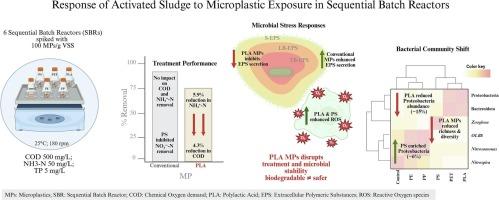常规微塑料和可生物降解微塑料对序批式反应器处理性能和细菌群落的差异影响
Q1 Environmental Science
引用次数: 0
摘要
微塑料(MPs)是污水处理厂(WWTPs)中新兴的污染物,但它们对生物处理过程的聚合物特异性影响仍然知之甚少。本研究系统比较了常规(聚乙烯(PE)、聚丙烯(PP)、聚苯乙烯(PS)、聚对苯二甲酸乙二醇酯(PET))和可生物降解(聚乳酸(PLA)) MPs在相同的序批式反应器(SBR)条件下(100颗粒/g VSS, 30天暴露)的影响。常规MPs诱导适度的微生物应激,增加活性氧(约为PS的2倍),但对COD去除(83 - 86%)和氨氧化(86 - 92%)的抑制作用最小。相比之下,PLA显著影响了系统性能,其COD和氨的去除率分别降低了4.3%和5.9%。PLA还抑制了胞外聚合物(EPS)的生成(与对照实验相比约0.7 - 0.8倍),并使变形杆菌中的丰度减少了约14.6%。PLA还导致微生物丰富度(Chao1指数)和多样性(Simpson指数)降低,这可能是由于生物膜的选择性形成,潜在的致病性分类群富集。这些发现引起了人们对可生物降解的MPs本质上更安全的普遍看法的关注,并强调了对污水处理厂中发现的不同MPs进行聚合物特异性风险评估的必要性。本文章由计算机程序翻译,如有差异,请以英文原文为准。

Differential impacts of conventional and biodegradable microplastics on treatment performance and bacterial community in sequencing batch reactors
Microplastics (MPs) are emerging contaminants in wastewater treatment plants (WWTPs), yet their polymer-specific impacts on biological treatment processes remain poorly understood. This study systematically compared the effects of conventional (Polyethylene (PE), Polypropylene (PP), Polystyrene (PS), Polyethylene terephthalate (PET)) and biodegradable (Polylactic acid (PLA)) MPs under identical sequencing batch reactor (SBR) conditions (100 particles/g VSS, 30-day exposure). Conventional MPs induced moderate microbial stress, evidenced by increased reactive oxygen species (~2-fold with PS), but had minimal inhibitory effects on COD removal (83–86 %) and ammonia oxidation (86–92 %). In contrast, PLA significantly affected system performance by reducing the removal of COD and ammonia by 4.3 % and 5.9 %, respectively. PLA also caused suppression (~0.7–0.8-fold as compared to the control experiment) in the production of extracellular polymeric substance (EPS), and abundance in Proteobacteria by ~14.6 %. PLA also led to reduced microbial richness (the Chao1 index) and diversity (the Simpson index), likely due to selective biofilm formation, with potential enrichment of pathogenic taxa. These findings raise concern over the generalized perception that biodegradable MPs are inherently safer and emphasize the need for polymer-specific risk assessments for different MPs found in WWTPs.
求助全文
通过发布文献求助,成功后即可免费获取论文全文。
去求助
来源期刊

Bioresource Technology Reports
Environmental Science-Environmental Engineering
CiteScore
7.20
自引率
0.00%
发文量
390
审稿时长
28 days
 求助内容:
求助内容: 应助结果提醒方式:
应助结果提醒方式:


